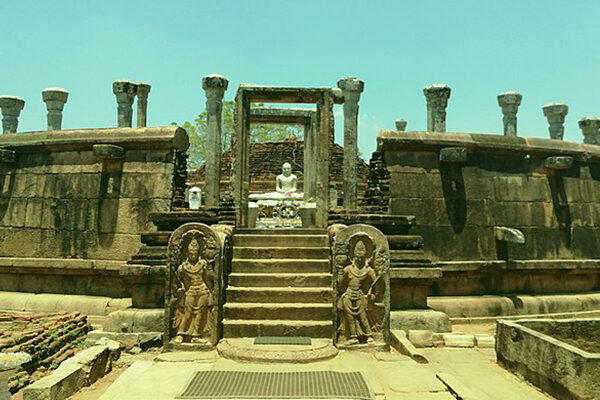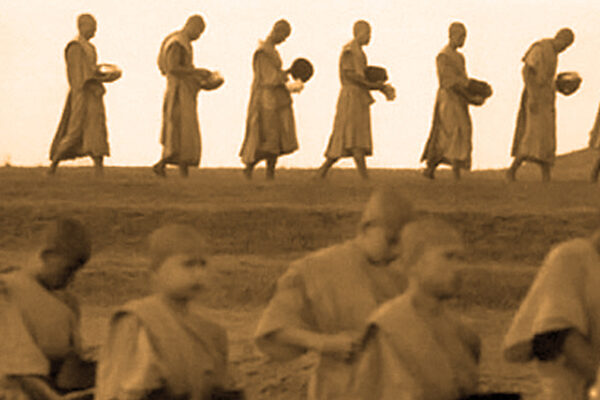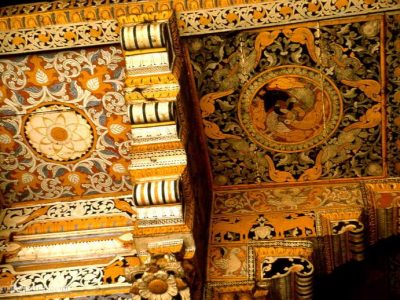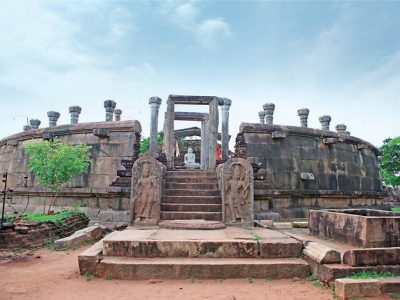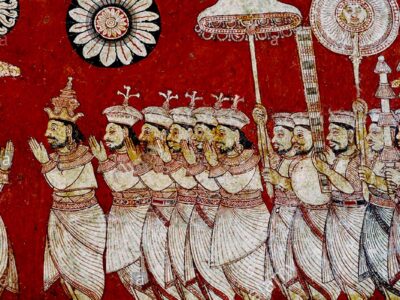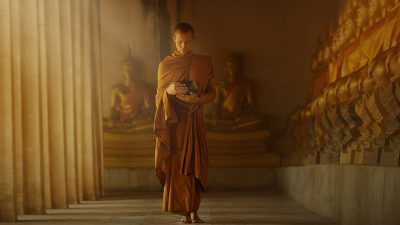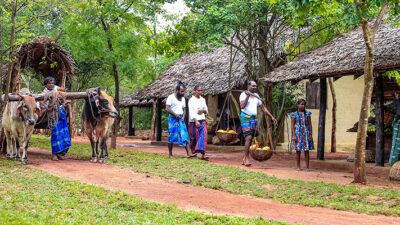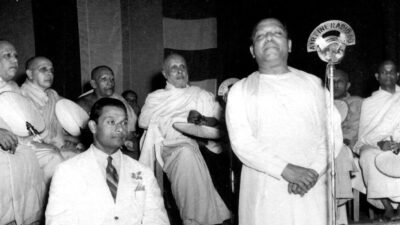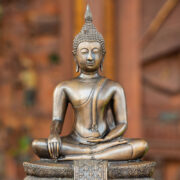By Ven. Bambarende Siri Sivali Maha Thera
By the time we come to the age of the Buddha, which is about the 6th Century B.C., Northern India had developed into a number of highly organized anapdadas of Kingdoms. According to the Pali Cannon the most famous of these states were Anga, Magadha, Kasi, Kosala, Vajji Malla, Cedi, Vaccha, Kuru, Pachala, Maccha, Surasena, Asaka, Avanti, Gandhara and Kamboja. More or less all these are included in modern Bihar, the United Provinces, the Punjab and Kashmir.
The spiritual allusions in the Buddhist Pitaka bear ample witness to the fact that the peasant of that age in whose kingdoms was a contented and happy man who looked after his flock of sheep and herd of cattle, a man who was civilized to such an extent as to be able to cultivate his lands systematically and methodically. He also went abroad and introduced the art of agriculture along with the Village Committee System and so many other things which served the purpose of civilized life. Apart from the landed property, the flock of sheep or the herd of cattle was one of the chief sources of income and as such, a patrician of wealth was the man who could command a numerical superiority in the domesticated animals, especially cattle. The most popular saying of that age was “Natthi go Samitam Dhanam” that there is no other property greater than cattle.
In the course of time, as these peasants went on advancing in civilization, they made great progress in the direction of arts and crafts such as weaving, pottery, carpentry, leather work, and so on. Before long we being to see signs of these trade forming themselves into organized trade unions, Campa, Rajagriha, Sravasti, Baranasi, Mithila, Pava, Cedi, Kavsambi, Indraprasatha, Kampilya, Mathura, Takshila, and Dvaraka were the centres of such highly organized trades. Even today some of these great cities keep up to their traditions. The Buddhist Jataka stories say that the trade and commerce of the country developed in leaps and bounds as a result of the above-mentioned industries and agricultural works. Hence the information available in the jatakas forms one of the richest sources with regard to the sociological conditions prevailing in India in ancient times. Although there are scholarly controversies over the period of jatakas, yet the evidence available at Bharahut and other places indicate that these stories existed even in the fourth century B.C. So the facts that we collect from these about the economic, political, social, industrial, trade, religious, and literary conditions of India at the time of the Buddha can be taken to be ‘very reliable and authentic. In Jatakas we find special reference regarding the setthis or financial magnates and the plutocrats of the age, sometimes they were wealthier than the actual ruler of the country. The fountain head of such enormous wealth was trade. Many jatakas such as Samudda Vanija, Baveru and Valahakassa bear witness to the trade with foreign lands and the extent to which international trade was gaining ground.
The development of the rural peasantry and the industrial urban population inevitably results in the birth of demand and clamor for political and citizenship rights. Hence during the Buddha age we see advance forms of social institutions and administrative councils such as gam sabhas, nigama sabhas and nagara sabhas. The Chief of a gam sabha or a village council was titled Gamini that of a nigama sabha or an urban council was called Nigama Setthi. The chief of a town or a municipal council was called Nagara Setthi. At that time the politically well-organized and fair-sized urban areas were known as Gana Rajaya. The head of the traders’ guild was called Seni Mukuya, and the chief of the craftsmen was called achariya. All these indicate that the administration of a Gana Rajaya would have been largely democratic. The janapadas or big provinces were either democratic or monarchical. In the Tripitaka we often come across such democratic states as Vajji and Pancala and such monarchical kingdoms as Magadha and Kosala.
Another remarkable feature that had developed by this time, i.e. the 6th century B.C., was the organized caste system of India. Although it is considered to be based on the division of the labour long before the time of the Buddha, the Brahmins had made the people believe that it is the wish of God. This belief is embodied in the fourth discourse of Bhagavat Gita as follows:-
“Caturvarnam Maydi Sristam Gunakarmavibhagasah
Tasya Kartarramapi Mam Vidyakartaramavyayam”
(The four castes were emanated by me, by the different distribution of qualities and actions; know me to be the author of them, though action less and inexhaustible.)
In accordance with this teaching the system of life known as Varnasramadharama began to take shape. There is ample evidence to believe that this might have been started in Vedic Period (2500 – 1500 B.C.) yet it appears to have matured quite after the Upanishadic Period (800-500 B.C.), which was characterized by fanatic worshippers of God. Prior to this i.e., during the Brahmanic Period (1500-800 B.C.) the ceremonial rites to gratify God or Gods and false asceticism to attain salvation were thriving. Animal sacrifice was greatly hailed.
It was against these practices that Jainism and Buddhism sprang up. The doctrine of Non-violence of Jainism went too far and became too extreme. Consequently even today it is not much appreciated in India. On the contrary Buddhism kept to the golden meaning drawing its followers from all strata of society which generally prefers moderation to extremism. The doctrine of Non-violence is not a monopoly of Jainism or of any other system of thought. Buddhism too is well-reputed for Non-violence. In Buddhism, it is taught through the Noble Eightfold Path. And that is as follows:-
- Right understanding of the true nature of existence;
- Right aspiration of self-renunciation, of goodness and of mercy;
- Right speech free from falsehood, harshness, slandering and useless talk’
- Right conduct of abstaining from killing, from dishonest taking and from adultery;
- Right livelihood which does not bring harm and suffering to other beings;
- Right endeavor to control anger and to avoid all bad actions of body, word and mind;
- Right attentiveness of mind;
- Right concentration of mind.
When one is to follow Eightfold Path there is no difficulty for one to be guided by Non-violence. In other words, the entire Eightfold Path is nothing but an outcome of Non-violence. Among Buddhists all do not practice this noble doctrine to the same degree or with the same speed. Hence we find four major sections of them the first and foremost of them are priests; second section formed of priestesses; the third is of laymen and the fourth is of lay-women.
Out of these the priests and nuns should remain unmarried. They cannot possess any private property. They live in separate huts with a daily routine of work. The main principles of their system of discipline are entirely democratic. It is only a very high type of ideal society that can have such democratic disciplines. And in the history of religion or in any other social organization the Buddhist priests were the first people to socialize their property.
In the beginning, Buddhist priests limited their activities to practicing meditation and propagating the Dhamma. Later on in order to facilitate the propagation of Buddhist teachings, educational activities were included in the daily routine of the priests. As a direct result of their taking part in educational enterprises from the sixth century onward there grew up several well-known universities in India called Nalanda, Vikramasila, Jagaddala, Odantapuri and so on. Thus there is no doubt about the fact that it was due to the educational efforts of the Buddhist monks that ancient Indian Society made tremendous progress.
Today there is one type of Buddhist monk in Ceylon, Siam and Burma, and another type in China, Japan and Tibet. The former belongs to the orthodox school, whereas the latter to the reformed school. These two schools are known as Hinayana and Mahayana. Their conditions are now very much different from those of former times. The duly ordained nuns are not found today in most of these countries. Ceylon too lacks Buddhist nuns.
The male and female members of the laity or the upasaka and upasika are expected to live a righteous and virtuous life looking after the order of the Sangha or priests and nuns. There are five percepts or rules of conduct which they have to observe daily. They are as follows:-
- Abstention from doing fatal injury to any living being;
- Abstention from taking things not given;
- Abstention from adultery or lawless sexual actions;
- Abstention from false speech;
- Abstention from distilled and fermented intoxicating liquors that are causes of heedlessness.
All these precepts are means of deliverance from ill.
Besides these, there are many other teachings, injunctions and customs that a Buddhist has to observe with regard to social behavior. In various scriptures at many places we see advice pertaining to matters economic being given to laymen. There is no place for exploitation of the poor or of the weak by the rich or by the strong man in Buddhism. The man who earns a livelihood is asked to do it just as the bee gathers honey from flowers without doing any harm to them. The Suttas such as Sigalovada and Vyagghapajja are full of such advice on household affairs. Instructions on similar matters are also found in the Catukka Nipata of Anguttara Nikaya. According to those a Buddhist is forbidden to deal in poisons commodities, deadly weapons, meat and liquor. Nor is he allowed to make profit by selling things at fancy price and by taking prohibitive interest on money lent. It is because the life of a Buddhist is expected to be righteous, harmless and full of virtues.
Devil dancing and such other superstitious sorcery were utterly condemned by the Buddha as highly misleading. The Buddhists are forbidden to practice ceremonial rites and obscene religious observances.
The Buddha never approved the caste system of India. Hence there are no Brahmina, Ksattriyas, Vaisyas and Sudras among the Buddhists. In this connection what the Buddha has said is very interesting. In the course of Vasala Sutta, He said:-
“No jaccavasala hoti – na jacea hoti brahmana;
Kammana vasalo hoti – kammana hoti brahmana”
(None is a low-caste by birth and none is a Brahmin by birth; one becomes low-caste by action and one becomes Brahmin by action)
Herein it is inevitable to point out that the Buddhist justice is the same for all and all are equal in the eyes of law. There is not a single true Buddhist institution where caste system is respected. Buddhists, therefore possess the spirit of true brotherhood that every individual should follow today.
Another thing that a Buddhist can enjoy is free-thinking. He is never asked to follow anything blindly. Following is how the Buddha advised some men in the Kalama Sutta:-
“Put not your faith in traditions merely because they are old and have come down to us through many generations;
Do not believe anything upon the ground of common report or because people talk a great deal about it;
“Believe not a thing merely because someone lays before you the written testimony of someone or other of the sages of old time;
“Do not believe anything that you have imagined, thinking you have received the inspiration from a God;
“Believe nothing upon the authority of your teachers or priests;
“Whatsoever, after the personal experience and investigation is found to agree with your own reason and tends to serve your own well-being, as well as the well-being of all other living beings – that cleave to as truth and shape your life in accordance therewith.”
The Buddha seems to have paid a great care for the other people’s sentiments in all his activities. Hence, he organized the order of the Sangha on democratic lines. Almost all Buddhist assembles and typically Buddhist activities bear witness to this. Although the Buddha had nothing to do with the outward politics of the country, he favoured democracy. In the Sattaka Nipata of the Anguttara Nikaya in a discourse with Vasakara, the Chief Minister of Magadha, the Buddha speaks very highly of the people’s Government of the Licchavis, their system of legislation, assembly, unity, law, and respect for elders, respect for women, respect for religion and the saints. He says further that such a democratic government cannot be crushed easily because it is well-favoured by the people.
Buddha held in esteem simplicity in life, economy, self-respect, monogamy, tolerance, friendliness, generosity and unity. It is because of these great ideals that the Buddhists are accustomed to simple habits. The good Buddhists never take pride in fashionable ways of living. They also are very generous in their common behavior. And unity is their aim of life.
In order to prove the greatness of Buddhist teachings, I must take another outstanding point. So far as social life of ancient India is concerned, it stands unique. In the history of India it was the Buddha for the first time that gave the largest freedom to women. He advocated their cause and said that woman too must enjoy all rights of citizenship and freedom. Every woman must be regarded as an independent person and thus, as an act of approval of such a principle. He admitted women to His order. Henceforward they could be ordained as nuns, or could live as lay-women with the privileges that men could enjoy without being slaves of men. To a Buddhist woman, marriage means nothing but a free partnership. She not only keeps her property separate but also retains her own ideas, habits and individuality.
In the Buddhist cannon women are classified into several categories such as mothers, daughters, wives, widows, servant maids, ordinary lay-women and nuns.
The highest honour is bestowed upon the mother and she is called sometimes “The Buddha of the Family.” Thus she is paid supreme respect in order to maintain a high standard of morals in society. There were some people in those days who lamented over the birth of a daughter. They liked only sons. When the King of Kosala begot a daughter he visited the Buddha and lamented the fact that his issue was a daughter. Thereupon the Buddha pleased him by convincing him that the daughter was as good as the son.




